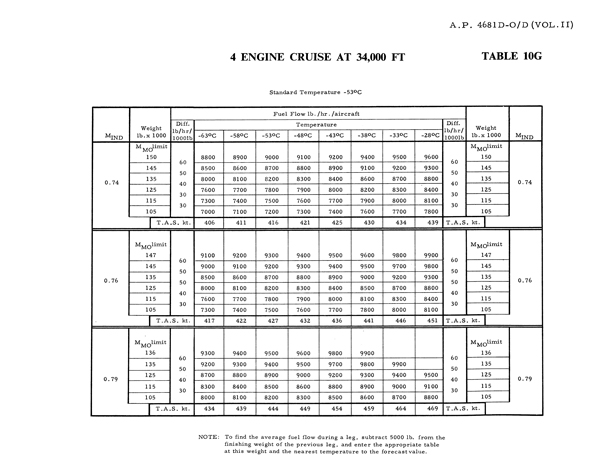Comet 4c - Cruise Performance
10/08/16 23:00

Fig.1: Page from the real Comet 4C Flight Operating Data.
Situation
Manufacturers rarely publish figures for lift or drag; they are design parameters, and not relevant or helpful to the crew when operating the aircraft. This is a problem for X-Plane developers, who need to know the correct drag figures for the flight model.
One way is to derive the drag from the performance data. In this, I am fortunate that aircraft from this era had no auto-throttle, so manufacturers published "cruise control" tables giving the approximate RPM required to cruise at the desired speed — enough to fill a book. This is a tremendous source of hard data.
Deriving the drag is like solving a complex equation with many variables. I have spent the last few years finding pieces of the puzzle. There are still some parts missing. For example, the manual only lists performance data for normal flight operations, not what happens if the pilots fly very high, or very fast and very low.
Action
To assess the model's performance against published flight data, I created a new function in my flight test plug in that flew the aircraft to the correct altitude and speed automatically, changed the all-up-weight in flight, and used a PID controller to vary the drag of the model until the engine RPM matched the quoted figure. A second PID controller varied the SFC of the engines to match the quoted fuel flow. Test results were published in a text file, which formed the basis of drag and SFC corrections.
Tests were in 1000 feet intervals from 1000 feet altitude to 40,000 feet. The manual quoted figures for holding patterns at 215 knots at lower altitudes, and cruise speeds at high altitudes. Cruise speeds included 275 knots, and 0.74, 0.76 and 0.79 Mach. The permutations and combinations required 525 samples within the overall cruise test. Even with the plug in, the full test took more than a day to run. Obviously, it had to be run again if I made modifications.
At this stage, I have only tested values for ISA (predecessor of ICAN) temperatures.
Results
Engine RPM figures compared with the real aircraft are excellent. All values are within 1% of the figures quoted in the Comet 4C manual.
Fuel flow had some peaks in the results. Until I find out whether the peaks were genuine, I have smoothed them. At an altitude of 34,000 feet, 0.79M and 145,000 lb. weight, the model will use 4% less fuel than the real thing. Otherwise 99% of values are within 2% of figures quoted in the manual, and 81% of values are within 1% of figures quoted in the manual.
Results confirmed in X-Plane 9.70 as well (GP: 11-08-2016)
Next step: descent tests.
--
GMM-P
(10-08-2016)
blog comments powered by Disqus
